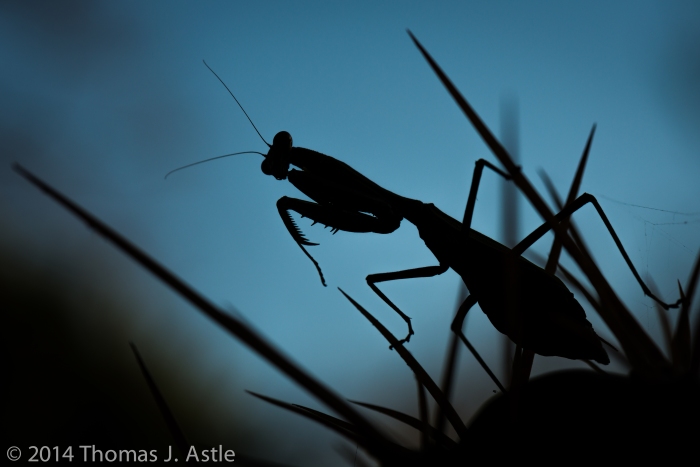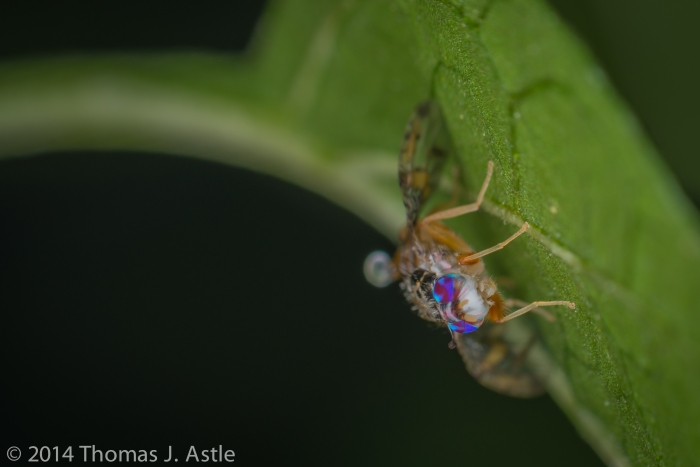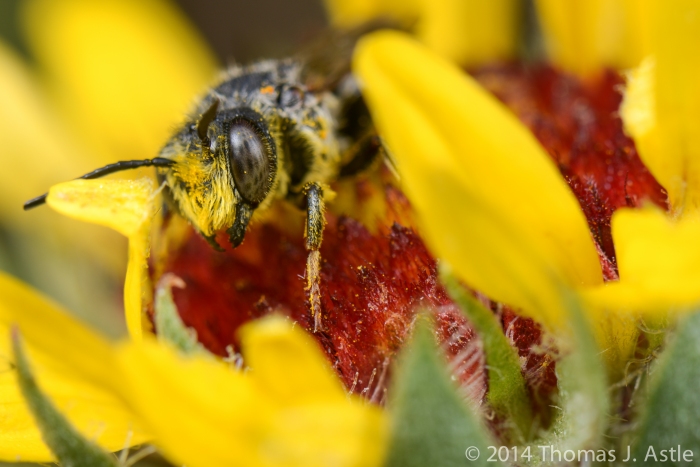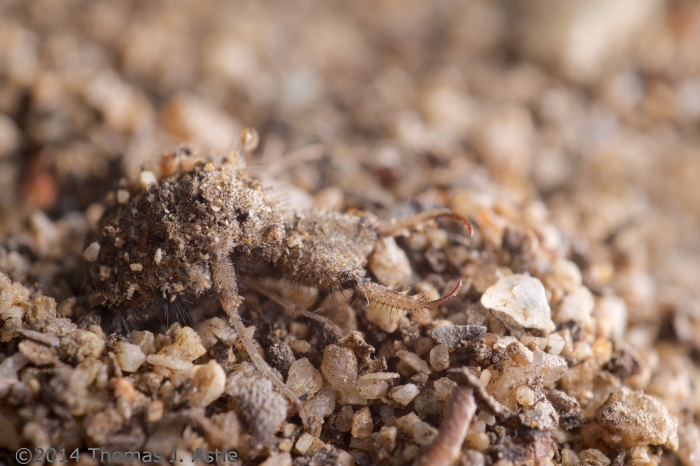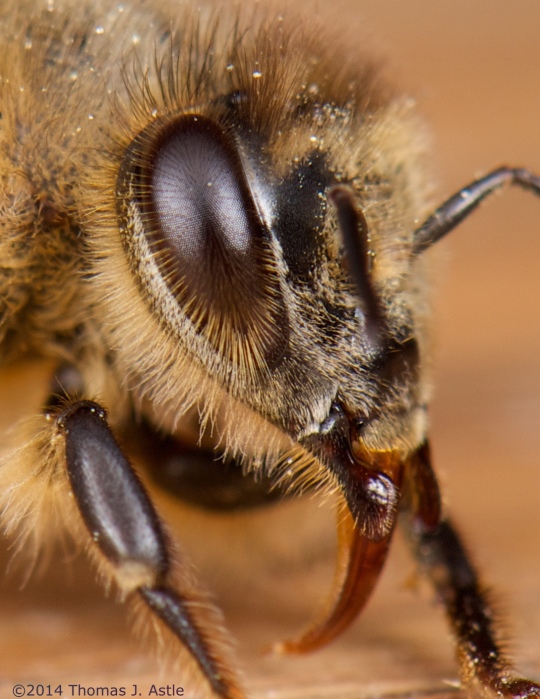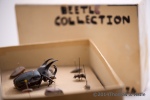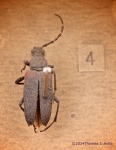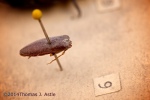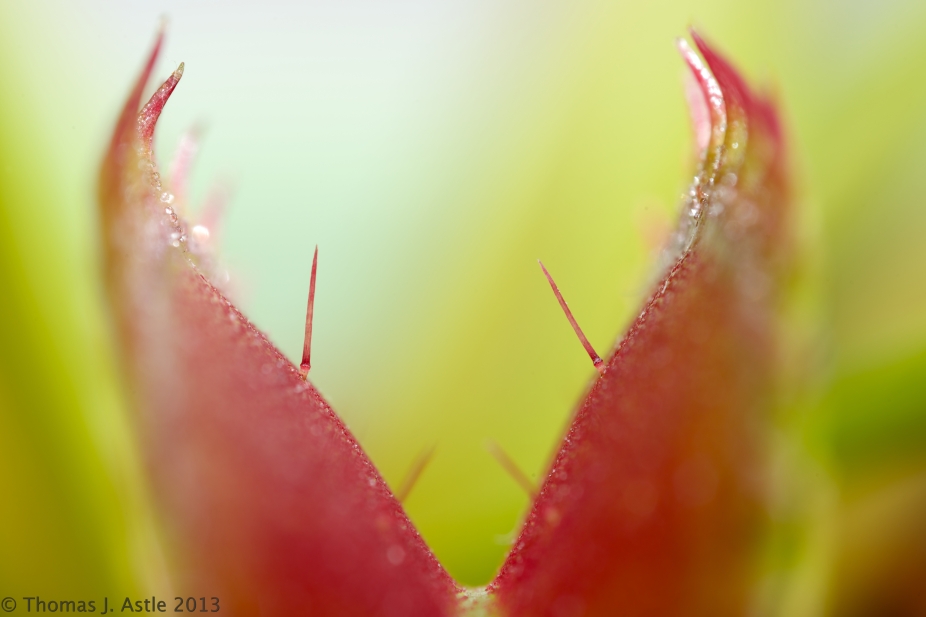Mantis Fugit
I like to spot praying mantises in my garden. Starting in early spring, I can usually find the tiny, just-hatched nymphs, only a few millimeters long, staking out territories. As spring and summer progress, I find larger and larger instars as they grow. (Each time the insect sheds its skin, it becomes the next instar, or growth stage; in the usual species found in my yard, the bordered mantis, there are six or seven instars from hatchling to winged adult.) It’s not unusual to find the same individual for a few days in a row, as they tend to hang out in roughly the same area. In the fall, the adults are easy to spot, because they’re large insects — especially the bulkier females, which despite finally having wings are too heavy to fly. Usually by mid-to-late November here in inland southern California, the adults mate and die, then I find them on the ground, and it’s time to wait out the winter for the next generation. Like many insects, they are seasonal, like leaves on deciduous trees; they go from pinhead-dancing nymphs to arthropod T-rexes in a few short months, then they’re gone.
But every once in awhile — like this year — I find one hanging on later than usual. These pictures are of the same female, taken on successive days during the last week of the year. Maybe in milder coastal areas they linger through December, but in my yard, this female holds the record. I know her days are numbered. There’s nothing much left in the garden for her to eat. It’s cold (for California) and we’ve even had a couple of light frosts this week. But I look for her every day, and I root for her to keep on keeping on.
I don’t know how, or whether, insects experience time. Does it move more slowly for them, so that to a mantis, a few months of life are like many decades to us? Of course, lacking an obsession with self-reflection or the concept of object permanence or a long history of artistic rumination on their own mortality, they may not experience time at all — they may just react moment to moment to whatever stimuli are in front of them then decide whether something is predator or prey, mate or rival. But in any case, the old mantis in my garden is still here. Whether she experiences the last days of 2014 as her twilight, or just moment by moment as they happen, it doesn’t matter. She’s still here. And I hope she’ll be here tomorrow.
Of course, Emily Dickinson wrote, “Hope is the thing with feathers,” so I guess my mantis doesn’t qualify for the metaphor. But feathers or not, she still has wings.
(Click Photos To Enlarge)
Let Us Spray (Invasive, part 2)
This psychedelic-eyed little fly is a Mediterranean Fruit Fly, one of the most infamous invasive pest species in fruit-growing regions of the U.S. People living in Southern California during the late eighties and nineties may remember the controversial helicopter spraying of Malathion across broad swaths of the region in an attempt to prevent disastrous losses in the agricultural industry. Oddly, people were a little cranky about chemicals being sprayed on them from helicopters. Especially chemicals with the prefix “mal” in them, the Latin root for which means “bad” or “evil,” such as: malfunction, malicious, malevolent, shopping mall. But we were assured the pesticide was safe, although it was recommended that everyone stay indoors and keep their pets locked up and cover their cars because the pesticide was delivered in a sticky, sweet, fly-attracting liquid. At one point, someone in charge actually swigged a big glass of (heavily-diluted) Malathion to prove how safe it was. (No word on his current health situation.)
Anyway, we no longer see formations of helicopters spraying chemicals (the helicopters now just follow high-speed chases for use on slow news days). Other, organic pesticides are usually spot-sprayed now (and as we all know, organic things are always safe, like rattlesnake venom and ricin). The other tactic used in their control was — and remains — the release of irradiated-until-they’re-sterile male individuals who then mate with wild females, but then of course produce no offspring. (The irradiating isn’t why they have day-glo eyes, by the way — that’s just the way they look.)
The fly in the photo is one of the released sterile ones; you can tell by the pink-red streaks on its forehead, between the eyes. The pink isn’t part of the fly’s natural color — it’s a dye. The idea is that scientists trapping the flies post-release can judge how well-dispersed the sterile flies are by checking for the dyed individuals; the dye shows up brightly under black lights, like the Jimi Hendrix poster in your basement. Now, when I first learned about this, I wondered who had this very strange job of decorating tiny flies. Just how small a brush would you need? When you got really good at it, could you paint little designs on the fly faces, like kids getting face-painted at a school carnival? And whose hands are that steady? Certainly one cup of coffee and you’d have to take the day off. Come to think of it, I remembered seeing a display of paintings on single grains of rice at the wonderful Museum of Jurassic Technology in Los Angeles. Maybe they hired the rice-grain artist. Then I learned the truth — the technique involves dyeing the cocoons. When the pupa hatches, the fly pushes its way out of the stained cocoon head first, thus smearing pink dye on its own face. No microscopic makeup kit needed. I guess that makes more sense… but my initial idea sounds more fun. Sure, it’s more labor intensive, but imagine some graduate student’s surprise when checking fly-faces under a microscope, and seeing a tiny fruit fly with a face painted to give him kitty whiskers or a bunny nose.
Daydream Bee-lievers
These are (as far as I can tell) five different bee species, and they’re all asleep — or at least resting. All these photos but one were taken in the same meadow in the mountains of Montana, within a few minutes of each other. It was around four in the afternoon, and the weather was getting stormy, so I stopped fishing (holding a graphite fly rod up in the air when there’s lightning nearby isn’t a good idea). The wind had come up, thunder was booming higher up the canyon, and the sun was obscured by clouds. I noticed that although many flowers had bees on them, none of the bees were feeding or collecting pollen. Despite the sudden storminess, the weather was still warm — the temperature was in the high 70s F — and in July in Montana, the day is far from over at four p.m. Nonetheless, no bees were busy. They were all just sitting there, one to a flower, as if taking a siesta while waiting for the weather to improve. I don’t know what cue caused the behavior — maybe a quick change in the air pressure, or the lack of sun, or the sudden wind, or maybe a combination of factors… in any case, they didn’t move at all on their various floral perches despite my leaning close with the camera.
The fifth image (the bee gripping the plant stem in its jaws) was taken the next day under virtually the same weather conditions and at almost exactly the same time of day, in another streamside mountain meadow a few miles from the first location. This bee really is asleep — a number of species of bees exhibit this behavior. You’ll note it’s not gripping the stem with anything but its jaws. And it was quite immobile — even when I carefully plucked the stem and moved it behind a boulder out of the wind, to improve my chances of getting a good photo, the bee didn’t stir.
When I was a kid, I hated to fall asleep quickly. I liked lying in bed in the dark, wondering random childhood wonderings — like, whether bugs slept, too. Now, I lie awake in bed in the dark because, well… at a certain age I found that falling asleep quickly was unlikely, whether or not I had something to wonder about. I’m a little jealous of the bees; it must be nice to be able to sleep whenever you need to wait out a storm.
But do they dream? I wonder.
(Click Photos to Enlarge)
Invasive
This odd-looking, colorful little critter is called a glassy-winged sharpshooter. It’s a little less than half an inch long, and it feeds on plant juices. These insects are found in the southeastern United States and northeastern Mexico, but apparently in the 1980’s (like me) they showed up in Southern California — where (unlike me) they had no natural enemies. In the oft-told tale of invasive species (see also: cane toads in Australia, mongooses — mongeese? — in Hawaii, and the-sun-never-sets-on British Empire), they quickly overran the place. We tend to think of invasive species as coming from somewhere much further away — it may seem odd that California can be “invaded” from the East Coast. On the other hand, we’ve always been a magnet for tourists. Anyway, these bugs turned out to be a vector for a grape-vine-killing bacterial disease, threatening an entire agricultural sector, not to mention endangering your evening glass of vino. From California, they then spread all over the Pacific, from Hawaii to Tahiti and even Easter Island. In some places they reached plague levels, until the introduction of a tiny parasitic wasp that lays its eggs on the sharpshooters’ eggs, which the wasp larvae eat. So give thanks for a tiny wasp — slayer of sharpshooters and savior of Sauvignon. To celebrate, I suggest a glass of (California) wine.
Arthropoda-sutra
I just returned from a quick trip to Montana. Mid-June is early spring there (when I visited in March, it was -22 Fahrenheit). In addition to the nesting birds and new fawns and hills full of wildflowers, I noticed that a lot of the smaller critters were busy as well, making hay while the sun shines, as they say. (I took plenty of photos of things not having sex, by the way. I just thought it was interesting, and — you know what? I don’t have to justify myself. It’s my damn blog.) Anyway, these are a sampling. The butterflies (best guess is a species called a Blue Copper) are normally hard to approach, but under these circumstances seemed not to notice me at all. It made photographing them easier, but does seem to be a poor strategy for avoiding hungry birds. On the other hand, the pretty little yellow wildflower they’re on is the lethally-named Meadow Death Camas — maybe making love near neurotoxic alkaloids is enough to keep predators at bay.
Catching the spider pair was a bit of luck — I noticed the male (the more slender of the two) among the needles of a pine tree, “dancing” nervously and plucking at bits of web; after a moment, the female emerged from her protected spot at the base of the needles, lured out by his string music. The whole encounter was over in maybe a minute — and the male survived the affair, which if you know spiders, you know is no small feat.
The small black flies, which I’ve been reliably informed are called “Dance Flies” (Family Empididae), are predators of other insects. They were, unlike the butterflies, flying quickly and were hard to photograph. I only managed one picture of them — and discovered it wasn’t a pair, but a menage a trois — with number trois not really enjoying the proceedings. Apparently male dance flies sometimes provide a “nuptial gift” to entice the female — they buy her dinner, as it were. In this case, the gift seems to be another dance fly, which the female was eating… all while mating and flying. Talk about multitasking.
The small longhorn beetles were one of dozens of pairs in the arrowleaf balsamroot flowers on a hillside covered with blooms. Bees and butterflies and cameras came and went, the beetles didn’t care. They just hung out on their bed of petals and pollen. It may lack the drama of sex amid toxic flowers or while eating freshly-killed meat or with the threat of cannibalism… but even between invertebrates, sometimes all you need are flowers and sunshine.
Fly Vs. Fly
(Click Photos to Enlarge)
So, I’ve been enjoying the springtime garden. It’s a beautiful time of year. Flowers are everywhere, the tomatoes are growing, the birds are singing, the neighbor’s leaf-blowers are humming. But the other day, while immersed in pastoral beauty, I noticed a tiny fly — very tiny, 2mm tops, barely larger than a fruit fly although chunkier — on the tip of a lime-tree leaf. The wee insect was holding another fly. But not the way you’d hold, say, a kitten. More like the way you’d hold, say, a hamburger. Or rather a milkshake, given that essentially what this critter is doing is sucking out its victim’s juices after jabbing its straw-like proboscis through its victim’s head. Anyway, I started looking around — these little predators were everywhere. From what I’ve seen so far, they prefer prey just a little smaller than themselves. They’re hard to photograph “in the wild” since I’m hand-holding the camera — even a slight breeze moves them wildly at the scale I’m trying to capture. But you get the idea. What I’m saying is, your yard is less Edward Hicks’s “Peaceable Kingdom” than it is Hieronymus Bosch’s “The Garden of Earthly Delights.” Once again, be glad you are big.
Disparity Of Size Is All That Saves Us
If you’ve ever noticed perfect little inch-or-so-wide pits in the fine sand or dirt of a park or trail or beach, and wondered what makes them… well, here you go. The pits are traps made by ant lions, the larval stage of an insect which, as an adult, resembles a dainty damsel fly or a large lacewing. The larvae, though, are hollow-fanged, venom-injecting beasties which lurk just below the bottom of these pits, waiting for an insect, often an ant, to stumble in. When the ant tries to escape, the ant lion flings sand at it to knock it back down, then seizes it and drags it under to drink its juices. The pictured ant lion is under 1/4-inch long. I think this is a good thing.
(Click to Enlarge)
The Hairy Eyeball
(Click to Enlarge)
This worker honeybee was resting on the oak threshold just outside my back door on a cool day. I got down on my belly and took this shot — the closer one is a crop of the first, to emphasize the compound eye. I never realized that honeybees have hairs literally growing out of their compound eyes — my best guess is that the hairs help collect extra pollen, plus perhaps keep pollen from adhering to the eye surface and blocking the bee’s vision as she spends the day stuffing her face in flowers.
Meet The Beetles
This is my childhood beetle collection. Somehow it has managed to survive, more or less intact, for over forty years. All the beetles, save one (the large rhinoceros beetle, a gift from a kid whose military dad was stationed in Indonesia), were collected by me in or around Billings, Montana, between 1968 and 1972. Or so. Give or take. More or less. In any case, every specimen is over forty years old. I pinned them in a See’s Candy box, which despite having a lid is not at all air-tight, and thus, they all have accumulated four-plus decades of infiltrating dust. Here is how the much-younger me made it: I lined the bottom of the box with cardboard to give the pins something to stick into, then glued a piece of paper on top of the cardboard for a cleaner appearance. I typed numbers on a typewriter and cut them out, then Elmer’s-glued them next to each beetle as I added it. I glued another piece of paper on the box’s lid and wrote “Beetle Collection” and in the lower right my initials “TA” so that, being thereby scientifically christened, no one would accidentally throw it away. A few of the specimens were pinned with thin, black, insect-mounting pins — but before I discovered the “right” tools in a science-supply catalog, I used whatever pins I could filch from my mother’s quilting. Pinning beetles is hard, literally — their elytra are tough, and hey, I was a kid, so sometimes the pin didn’t go in straight. Meaning I’d try again. And again. Which explains why several of the beetles have more than one hole in their wing covers.
Some days I can scarcely remember where I set my coffee cup a moment before — but I can tell you where I got every single beetle in this collection. In some cases, I can tell you with GPS-beating specificity. A few of the beetles I found already dead, but most I captured alive. Usually I kept them as “pets” until they keeled over of their own accord, but some I hurried to their demise in a sealed killing jar, in which I used alcohol-soaked cotton balls to euthanize them. Later (from the wonderful science-supply catalog) I bought a small vial of something called “dispatching fluid,” which killed bugs dead right quick, and which was cheerfully sold to ten year-old boys in the 1960s whether they asked their parents or not, which they didn’t.
I got back into photography over the last couple of years after a long absence. I was fortunate to be able to attend a macrophotography workshop in Belize in 2013, a few photos from which I posted earlier. I’ve taken a few shots I really like… but I’ve been trying to figure out a way to do something different, something a bit more personal. I was sitting in my home office a couple of weeks ago, when I noticed, on a lower shelf, my old beetle collection. It’s been on the shelf, boxed up, for a long time.
So I opened it. And took some pictures.
I did not alter the specimens. I photographed them as objects, impaled and imperfect bits of chitinous memory, not as natural history subjects. They are dusty and damaged and poorly-mounted. They are numbered but not labeled. They are, quite literally, nothing more than a bunch of dead bugs. But I can hear the wind in the lodgepole pines as I gripped the wooden handle of my butterfly net — taking a break from fly-fishing — and feel the crunching gravel under the thin soles of my sneakers in the hot dusty alley behind my house and smell the alcohol-soaked cotton balls and feel the living insects’ spiky strong legs pushing against my fingers and I can remember watching them alive, in jars big and small, tunneling in dirt or devouring dropped-in earthworms, and I can even conjure the sensation of cool white glue on my fingertips as I placed numbers next to them in the poorly-sealed candy box. I can remember all of this, thin slices of gloriously-unsupervised childhood.
We value rare things: works of art, lifelong friendships, vacations with no rain. I doubt the specimens in this collection are anything beyond mildly out of the ordinary; it is, after all, unlikely that a kid sticking beetles in a box forty-some years ago discovered a new species. But the collection as a whole? It’s a singularity. No one else has one just like it, no one in the whole world.
Entrapment
(Click to Enlarge)
An end-on view of a Venus flytrap. The spiky things in the center aren’t the trap’s teeth — they are tiny trigger-hairs within the trap, thinner than a human hair. For the trap to close, at least two of these hairs must be touched in succession. I took this shot with a reversed 28 mm lens, which is a relatively inexpensive technique for shooting up close. A 28mm is a wide-angle lens, which many people already own. For about 17 bucks, I bought a reversing ring, which screws onto the front of the lens like a filter, and then allows the lens to be mounted on the camera backward. Doing this means you lose all electronic control over the lens, but since autofocus is of limited value with macro shooting, it’s not a big handicap. Plus, the level of magnification is really impressive.
-
Recent Posts
Websites I Like
-
Join 95 other subscribers
- Copyright notice: Unless stated otherwise, all text and photos appearing on this blog are © 2014 Thomas J. Astle and etimoss.com, and may not be reproduced without explicit permission. But I'll probably give you permission if you ask me nicely.
Archives





